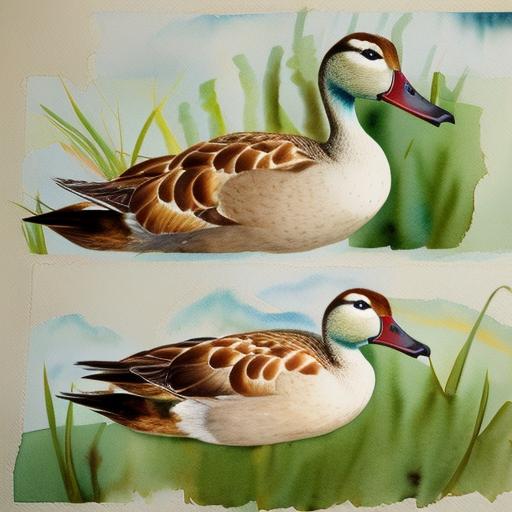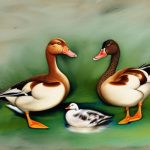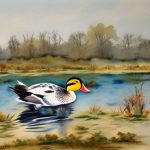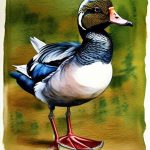Brown duck breeds are a popular choice for many duck enthusiasts due to their beautiful coloring, friendly disposition, and versatility. These breeds come in a variety of shades of brown, ranging from light tan to deep chocolate, and are known for their hardiness and adaptability to different climates. Brown ducks are also valued for their egg-laying abilities, making them a practical choice for those interested in raising ducks for both meat and eggs. In this article, we will explore the characteristics, popular breeds, care and maintenance, uses and benefits, as well as breeding and reproduction of brown duck breeds.
Key Takeaways
- Brown duck breeds are known for their unique characteristics and physical appearance, making them popular among duck enthusiasts.
- Some popular brown duck breeds include the Cayuga, Indian Runner, and Saxony, each with their own distinct traits and qualities.
- Proper care and maintenance of brown duck breeds includes providing a suitable living environment, balanced diet, and regular health check-ups.
- Brown duck breeds are valued for their uses and benefits, such as egg production, pest control, and as pets or show animals.
- Breeding and reproduction of brown duck breeds require careful consideration of genetics, mating practices, and incubation of eggs to ensure healthy offspring.
Characteristics and Physical Appearance of Brown Duck Breeds
Brown duck breeds are known for their medium to large size, with a sturdy build and a slightly elongated body. They have a rounded head with a medium-length bill and expressive eyes. Their plumage can vary in shades of brown, with some breeds having darker markings on their wings and tails. The feathers of brown ducks are often glossy and can have a subtle iridescence in the sunlight. Their legs and feet are typically orange or yellow in color, and they have webbed feet that make them excellent swimmers. Brown ducks also have a calm and friendly disposition, making them a popular choice for backyard flocks and small farms. They are known for being good foragers and can thrive in a variety of environments, from free-ranging on a pond to living in a coop or pen.
Brown duck breeds are also known for their excellent egg-laying abilities. They are prolific layers, with some breeds laying up to 200 eggs per year. The eggs are typically large and have a slightly tinted shell, making them an attractive choice for those looking to raise ducks for eggs. In addition to their egg-laying abilities, brown ducks are also valued for their meat. Their flavorful and tender meat makes them a popular choice for those looking to raise ducks for meat production. Overall, the characteristics and physical appearance of brown duck breeds make them a versatile and practical choice for those interested in raising ducks for both eggs and meat.
Popular Brown Duck Breeds
There are several popular brown duck breeds that are favored by duck enthusiasts for their unique characteristics and qualities. One of the most well-known brown duck breeds is the Khaki Campbell. This breed is prized for its excellent egg-laying abilities, with hens laying up to 300 eggs per year. Khaki Campbells have a khaki-colored plumage with darker markings on their wings and tails, and they are known for their friendly and sociable nature. Another popular brown duck breed is the Indian Runner. This breed is known for its upright stance and distinctive tall, narrow body shape. Indian Runners are excellent foragers and are valued for their egg-laying abilities as well as their unique appearance.
The Welsh Harlequin is another popular brown duck breed that is known for its beautiful coloring and calm temperament. This breed has a light brown plumage with subtle iridescent markings, and they are excellent layers, with hens laying up to 250 eggs per year. The Cayuga is a unique brown duck breed that is known for its iridescent greenish-black plumage that appears brown in certain lights. Cayugas are valued for their meat as well as their egg-laying abilities, making them a practical choice for those looking to raise ducks for both purposes. These popular brown duck breeds each have their own unique characteristics and qualities, making them a valuable addition to any duck enthusiast’s flock.
Care and Maintenance of Brown Duck Breeds
Proper care and maintenance are essential for keeping brown duck breeds healthy and happy. Providing a suitable living environment is crucial, whether it’s a spacious coop or a secure pen with access to water for swimming. Brown ducks also require a balanced diet that includes a high-quality commercial feed, fresh water, and access to forage. It’s important to provide adequate shelter from the elements, especially during extreme weather conditions, to ensure the well-being of the ducks.
Regular health checks are also important to monitor the overall health of the ducks and address any potential issues promptly. This includes keeping an eye out for signs of illness or injury, as well as providing routine vaccinations and parasite control. Additionally, maintaining good hygiene in the duck’s living environment is crucial to prevent the spread of disease and ensure the ducks remain healthy.
Another important aspect of caring for brown duck breeds is providing them with mental stimulation and enrichment. Ducks are intelligent animals that benefit from activities that keep them engaged and entertained, such as providing them with access to water for swimming, toys to play with, and opportunities to forage for food. By providing proper care and maintenance, brown duck breeds can thrive and lead happy, healthy lives.
Uses and Benefits of Brown Duck Breeds
Brown duck breeds offer a wide range of uses and benefits that make them a valuable addition to any farm or homestead. One of the primary uses of brown duck breeds is for egg production. Many brown duck breeds are prolific layers, producing large eggs with rich yolks that are prized by home cooks and bakers alike. Duck eggs are known for their rich flavor and nutritional value, making them a popular choice for those looking to raise ducks for eggs.
In addition to egg production, brown duck breeds are also valued for their meat. Duck meat is known for its rich flavor and tender texture, making it a popular choice for culinary purposes. Whether it’s roasted, grilled, or used in soups and stews, duck meat is a versatile ingredient that is enjoyed by many.
Brown duck breeds also offer benefits beyond their egg-laying and meat production capabilities. Ducks are excellent foragers and can help control pests in the garden or on the farm by eating insects and other small creatures. Their manure is also valuable as a natural fertilizer that can be used to improve soil health and fertility.
Overall, the uses and benefits of brown duck breeds make them a practical choice for those looking to add diversity to their farm or homestead while enjoying the many products and services that ducks provide.
Breeding and Reproduction of Brown Duck Breeds
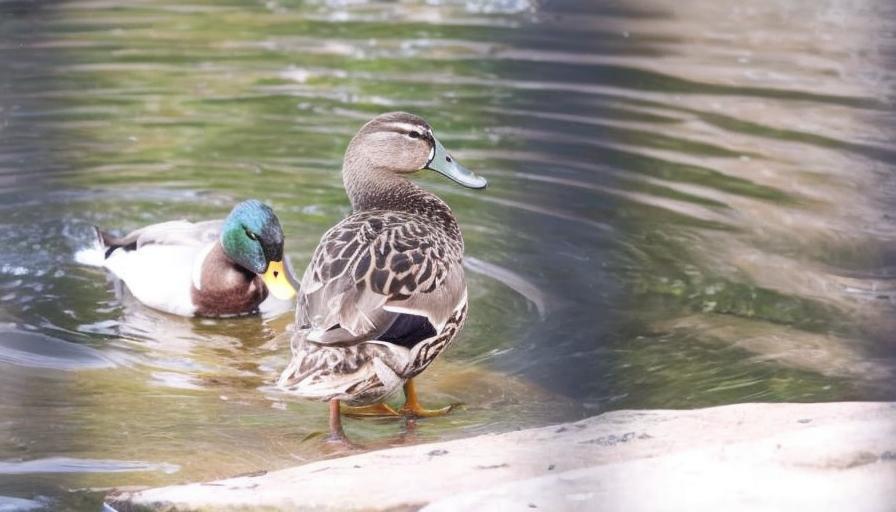
Breeding and reproduction are important aspects of raising brown duck breeds, whether it’s for maintaining a sustainable flock or producing offspring for sale or exhibition purposes. When breeding brown duck breeds, it’s important to select healthy, well-tempered individuals with desirable traits such as good egg-laying abilities or meat quality.
Ducks typically reach sexual maturity at around 5-7 months of age, at which point they can begin mating and laying eggs. It’s important to provide suitable nesting areas for broody hens to lay and incubate their eggs if natural breeding is desired. Alternatively, artificial incubation can be used to hatch duck eggs if natural breeding is not feasible.
Once the eggs hatch, it’s important to provide proper care for the ducklings to ensure their health and well-being. This includes providing a warm, dry environment, access to clean water, and a balanced diet that meets their nutritional needs.
Breeding and reproduction of brown duck breeds require careful planning and management to ensure the health and vitality of the flock while achieving desired breeding goals. By following best practices for breeding and reproduction, duck enthusiasts can maintain healthy flocks and produce offspring with desirable traits.
Conclusion and Summary of Brown Duck Breeds
In conclusion, brown duck breeds offer a wide range of characteristics, uses, and benefits that make them a valuable addition to any farm or homestead. From their beautiful coloring and friendly disposition to their excellent egg-laying abilities and meat production capabilities, brown duck breeds are versatile animals that can provide a variety of products and services.
Proper care and maintenance are essential for keeping brown duck breeds healthy and happy, while breeding and reproduction require careful planning and management to maintain healthy flocks with desirable traits.
Whether it’s for egg production, meat, pest control, or simply enjoying their company, brown duck breeds offer many advantages that make them a practical choice for those looking to raise ducks. With their unique qualities and valuable contributions, brown duck breeds continue to be a popular choice among duck enthusiasts around the world.
If you’re considering raising brown duck breeds, you may also be interested in learning about the ideal flooring for a chicken coop. The article “The Best Flooring for Your Chicken Coop” on PoultryWizard provides valuable insights into creating a comfortable and hygienic environment for your poultry. Understanding the importance of proper flooring can contribute to the overall well-being and productivity of your ducks and chickens. Check out the article here to enhance your knowledge on this essential aspect of poultry care.
FAQs
What are some common brown duck breeds?
Some common brown duck breeds include the Indian Runner, Khaki Campbell, Cayuga, and Saxony.
What are the characteristics of brown duck breeds?
Brown duck breeds typically have brown feathers, ranging from light tan to dark chocolate brown. They are known for their hardiness, good foraging abilities, and calm temperament.
What are the uses of brown duck breeds?
Brown duck breeds are often raised for their meat, eggs, and pest control abilities. They are also popular as backyard or small farm pets due to their friendly nature.
What are the care requirements for brown duck breeds?
Brown duck breeds require access to water for swimming and foraging, a balanced diet, shelter from predators and the elements, and regular veterinary care to maintain their health and well-being.
Are brown duck breeds good for beginners?
Yes, brown duck breeds are often recommended for beginners due to their hardiness, ease of care, and friendly disposition. They can be a great introduction to raising ducks for those new to poultry keeping.
Meet Walter, the feathered-friend fanatic of Florida! Nestled in the sunshine state, Walter struts through life with his feathered companions, clucking his way to happiness. With a coop that’s fancier than a five-star hotel, he’s the Don Juan of the chicken world. When he’s not teaching his hens to do the cha-cha, you’ll find him in a heated debate with his prized rooster, Sir Clucks-a-Lot. Walter’s poultry passion is no yolk; he’s the sunny-side-up guy you never knew you needed in your flock of friends!

